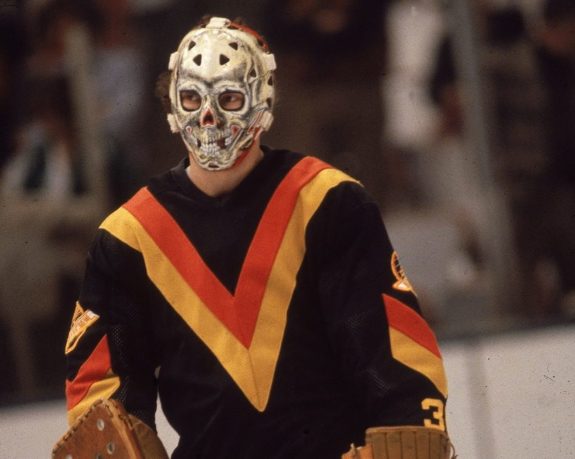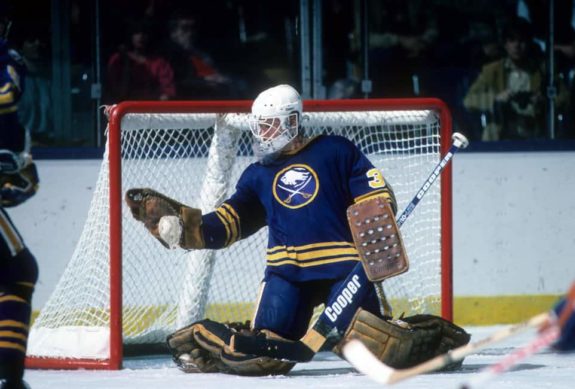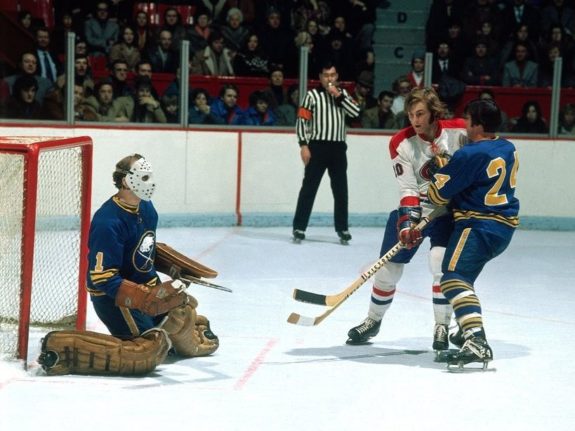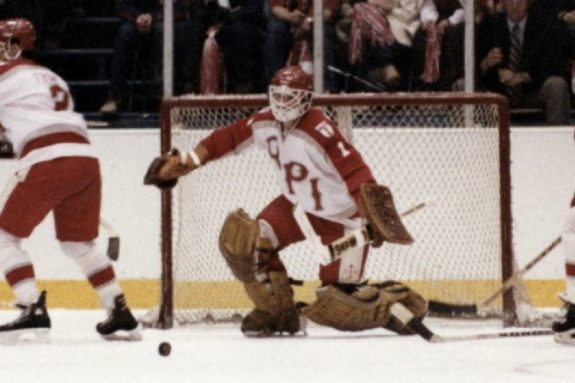Goaltending is said to be the most important position in the sport, and frankly, arguing against that is difficult. No hockey team at any level has ever amounted to anything without excellence in goal, and the greatest goaltenders of all time stand out as a result.
Every NHL team has had at least one formidable netminder in their history. Fans of the Buffalo Sabres have been spoiled with the likes of Dominik Hasek and Ryan Miller. But the team has just as many (if not more) who, for some reason, haven’t received as much recognition. Here’s a look at the five most underrated goaltenders in Sabres’ history, and why they’re deserving of more credit than they’ve received.
No. 5 – Gary Bromley
Unlike others on this list, it would be easy to forget that Gary Bromley was a Sabre since he was only with the team for parts of three seasons. But, in that time, he had a considerable impact. At age 24, Bromley was thrust into the starting role as a rookie in 1974-75, which also happened to be the year the Sabres took off. After mixed results through their first four seasons, Buffalo took the hockey world by storm that season, finishing second in the NHL and advancing to the Stanley Cup Final.

Bromley didn’t carry the Sabres by any means. Their high-powered offense led by the French Connection did that. He more than played his part, however, starting 50 games and recording 26 of the team’s 49 wins. His 3.10 goals-against average (GAA) and .873 save percentage (SV%) aren’t impressive by modern standards, but goaltending statistics looked very different in those days. But though he started over half of his team’s regular season schedule, the man known as “Bones” didn’t appear at all during Buffalo’s playoff run.
The reason was never made exactly clear. Perhaps head coach Floyd Smith didn’t trust the rookie and opted for the more experienced Gerry Desjardins and Roger Crozier instead. But this effectively marked the end of his career with the Sabres. He played just one game the following season before finding himself in the World Hockey Association. Nevertheless, Bromley was a valuable piece of the first truly great Buffalo team and should always be remembered as such.
No. 4 – Tom Barrasso
It’s admittedly a stretch to call Tom Barrasso underrated given his lengthy list of accomplishments, but he is in the scope of the Sabres. Unlike the successful teams of the 1970s and ’90s, the 1980s were a strange decade for the Sabres filled with mixed results. As a result, many who laced up for the team in that period tend to be overlooked, Barrasso included. The Massachusetts native was selected fifth overall by Buffalo out of high school in 1983 and opted to join the team immediately without playing in the junior or collegiate ranks.

Such a move was unprecedented at the time and it may have seemed that Barrasso was out of his mind, but he immediately proved he wasn’t. That season, he became just the third goaltender ever to be awarded both the Calder and Vezina Trophies as Rookie of the Year and Goaltender of the Year, respectively. It couldn’t have come at a better time for the Sabres, who had lacked a true star goaltender to that point. He took off from there and held down the crease at Buffalo Memorial Auditorium for parts of the next five seasons, adding the William Jennings Trophy in 1985. His excellence continued even after the team declined in the latter part of the decade.
Related: They Wore It Once: Sabres Players and Their Unique Numbers
It’s possible that Barrasso isn’t remembered much in the annals of Sabres history because he wasn’t with the team for as long as he should have been. In Nov. 1988 he was traded to the Pittsburgh Penguins in exchange for the fourth-overall pick, Darrin Shannon — an ill-fated move designed to jump-start Buffalo’s struggling offense. Barrasso is unquestionably a top-five goalie in Sabres history, perhaps even top-three. But, for whatever reason, his name isn’t held in the same regard as Hasek or Miller, and he’s yet to be inducted into the team’s Hall of Fame. He’ll receive his long-overdue induction into the Hockey Hall of Fame later this year.
No. 3 – Roger Crozier
Among Sabres fans, Roger Crozier is the answer to a commonly asked trivia question: Who was the team’s very first goaltender? The legend still doesn’t get his due in Buffalo despite that, however. Acquired from the Detroit Red Wings during the 1970 NHL Expansion Draft, Crozier started the team’s first-ever game, fittingly donning No. 1.
He was integral to the Sabres’ early years and backstopped them while they were growing as a team and searching for an identity. His statistics weren’t impressive (take that with a grain of salt since it was the 1970s and the Sabres weren’t amazing at first), but he still managed to hold down the fort despite battling severe health issues that included pancreatitis.

His finest hour was the legendary Game 3 of the 1975 Stanley Cup Final, dubbed “the Fog Game.” He started on the bench but stepped in in relief of Gerry Desjardins, whom the Philadelphia Flyers chased after three first-period goals. Despite the terrible visibility in the arena and a severe illness, Crozier stopped all but one shot to help his team rally and win the game on Rene Robert’s memorable overtime goal. The team eventually lost the series in Game 6 but wouldn’t have even made it that far had their aging netminder not stood on his head.
Crozier stayed in Buffalo until he was traded in 1977. He tragically passed away from cancer in 1996 at just 53 years old. He was far from the best goaltender ever to wear the Sabres’ uniform, but his contributions should never be forgotten.
No. 2 – Daren Puppa
After Barrasso was traded, the Sabres suddenly had a gaping hole in net and needed someone to step up. In stepped the towering 6-foot-4 Daren Puppa. Exceedingly tall for a goaltender in those days, Puppa had to battle for the starting job but eventually captured it despite a grizzly arm injury in Jan. 1989. He rewarded the team’s faith in him with an outstanding 1989-90 season, leading the NHL with 31 wins alongside a 2.89 GAA and .903 SV%. He was named an All-Star and finished second to Hall of Famer Patrick Roy for that year’s Vezina Trophy.

With him in goal, the Sabres continued to improve into the 1990s. However, like Barrasso, Puppa left abruptly in an ill-advised trade. Hasek came to Buffalo for the 1992-93 season, but the team evidently believed their goaltending was still insufficient. Though he was still playing well, Puppa was sent to the Toronto Maple Leafs with Dave Andreychuk and a first-round pick in exchange for Grant Fuhr in Feb. 1993, a deal that is still baffling 30 years later.
Fuhr didn’t exactly work out for the Sabres, but it didn’t matter, as Hasek emerged not long after and became one of the biggest stars in the history of the game. Puppa’s time in Buffalo tends to be forgotten because he directly preceded one of the greatest players of all time. It doesn’t change the fact that he stepped up for the Sabres under tough circumstances and did a very admirable job.
No. 1 – Martin Biron
Martin Biron‘s contributions to the Sabres largely fly under the radar through no fault of his own. The timing of his arrival was less than ideal, as the team was forced to slash its payroll not long after (for reasons that would be revealed later). Hasek was traded to the Detroit Red Wings in the summer of 2001, a moment Sabres fans will never forget. At the age of 24, Biron was suddenly thrust into the No. 1 role and had the unenviable task of following one of the greatest goaltenders ever. The Quebecois was not daunted, however, and embraced the challenge.
He started a whopping 72 games that 2001-02 season, going 31-28-10, despite a very impressive 2.22 GAA and .915 SV%, a clear indicator of the Sabres’ steep decline. It only got worse from there, and the team very nearly relocated the following season amidst the fallout of a fraud scandal by parent company Adelphia. They were rescued by new ownership that March and saw an improved 2003-04 campaign in which they narrowly missed the playoffs despite their goaltender’s best efforts.
After the 2004-05 lockout canceled the entire season, Miller emerged as the new starter, and Biron was relegated to the backup role. He handled the switch with grace and continued his strong play, winning 13 consecutive games that season while Miller was out with a hand injury. He eventually requested a trade, which was granted in Feb. 2007. The Sabres lost a core piece that day and they struggled to find a stable backup in the years that followed.
Biron’s legacy speaks for itself, and he would surely receive far greater recognition had he not been stuck between the two greatest goaltenders in franchise history. Though he wasn’t as talented as Hasek or Miller, his contributions were every bit as important. He shouldered the team through their most arduous period and always put the team first, even when it was at his own expense. One of the most beloved figures in Sabres history thanks to his goofy personality and charity work, Biron has a special place in the heart of the team’s fanbase.
If anything, this list proves that hockey fans in Western New York have had quite a few good players to cheer for over the years. What other goaltenders in Sabres history do you think deserve more credit?
